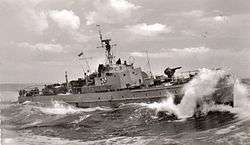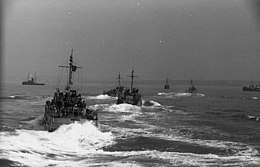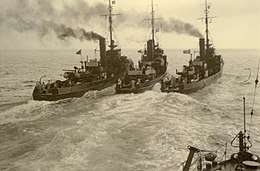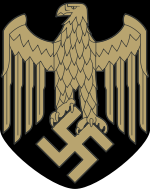R boat
The R boats (Räumboote in German, meaning minesweeper) were a group of small naval vessels built as minesweepers for the Kriegsmarine (German navy) before and during the Second World War. They were used for several purposes during the war, and were also used post-war by the German Mine Sweeping Administration for clearing naval mines.
 Aldebaran class R boat | |
| Class overview | |
|---|---|
| Name: | Räumboote or Minenräumboote |
| Builders: | Abeking & Rasmussen |
| Operators: |
|
| General characteristics | |
| Type: | Minesweeper |
| Displacement: | 160 t (max) |
| Length: | 41.1 m (134 ft 10 in) |
| Beam: | 5.80 m (19 ft 0 in) |
| Draught: | 1.60 m (5 ft 3 in) |
| Propulsion: | 2x MAN diesel engines; 1,836 hp |
| Speed: | 20 kn (37 km/h; 23 mph) |
| Range: | 1,100 NM (2,000 km) |
| Complement: | up to 38 |
| Armament: |
|

_in_1939_(26787005191).jpg)

Operational use
A total of 424 boats were built for the Kriegsmarine before and during World War II. The German Navy used them in every theatre including the Baltic, Mediterranean and the Black Sea. In addition to its designed use as minesweepers, these boats were used for convoy escort, coastal patrol, minelaying and air-sea rescue.
About 140 R boats survived the war and these were distributed amongst the Allies. Some were used by the German Mine Sweeping Administration (GMSA) to clear western Europe of naval mines. Twenty-four boats were transferred back to the post-war German Navy, the Bundesmarine, in 1956 and were used until the late 1960s. An unusual feature of these ships is the use of Voith Schneider Propellers on approximately one quarter of the boats for extra maneuverability.
Additionally, dozens of captured vessels from France, United Kingdom, the Netherlands and Italy were used as foreign R-boats (R-boote Ausland) and were designated with RA-, RH- and RD- prefixes. A further 8 coastal motor fishing boats were designated as auxiliary R-boats and named R111-R118 in the 11th R-boat flotilla.
R boat classes
| Class | Boats in class | Displacement | Length | Builders[1] | Notes |
|---|---|---|---|---|---|
| R1 | R1–R16 | 60 long tons (61 t) | 26 m | Lürssen, Bremen-Vegesack Abeking & Rasmussen, Lemwerder Schlichting, Travemünde |
Built 1929–34[2] |
| R17 | R17–R24 | 115 tons | 37 m | Schlichting, Travemünde, Abeking & Rasmussen |
Built 1934–38[3] |
| R25 | R25–R40 | 110 tons | 35.4 m | Abeking & Rasmussen Schlichting, Travemünde |
Built 1938–39[3] |
| R41 | R41–R129 | 125 tons | 37.8 m | Abeking & Rasmussen Schlichting, Travemünde |
Built 1939–43 |
| R130 | R130–150 | 150 tons | 41.1 m | Abeking & Rasmussen | Built 1943–44[4] |
| R151 | R151–217 | 125 tons | 35.4 m | Built 1940–43 | |
| R218 | R218–300 | 140 tons | 39.2 m | Built 1943–45, R291–300 unfinished at the end of the war | |
| R301 | R301–312 | 160 tons | 41 m | Built 1942–45, two 533 mm torpedo tubes added | |
| R401 | R401–448 | 140 tons | 39.2 m | Launched 1943–45 mostly not completed at end of the war |
R boat units
In the inter-war years and during the Second World War, a total of twenty Räumboots-Flottille (German for "Minesweeper Flotillas") were created. While most were dissolved late in the war or after the German surrender, a few were kept for use by the German Mine Sweeping Administration (GMSA) and dissolved post-war. An additional flotilla was created in the immediate post-war, also for use by the GMSA.[5]
See also
- Schnellboot, known to the Allies as E-Boats
- Motor Launch for the British equivalents
- M-class minesweeper (Germany) for larger German World War 2 minesweepers
- Sperrbrecher for another type of German World War 2 minesweeper
References
Notes
- Lenton 1975, pp. 330–331.
- Lenton 1975, p. 319.
- Lenton 1975, p. 320.
- Lenton 1975, p. 321.
- "Räumboots-Flottillen". Lexikon der Wehrmacht, Räumboots-Flottillen (in German). Andreas Altenburger (webmaster). Retrieved 2014-05-04.
Bibliography
- Conway's All The World's Fighting Ships 1922–1946
- Hervieux, Pierre "German Motor Minesweepers at War 1939–1945" in Warship 2002–2003, Conway's Maritime Press
- Lenton, H. T. German Warships of the Second World War. London: Macdonald and Jane's, 1975. ISBN 0356-04661-3.
Online sources
Further reading
- Erich Gröner; Dieter Jung; Martin Maass (November 1991). German Warships, 1815–1945: U-Boats and Mine Warfare Vessels (rev. ed.). Naval Inst Press. ISBN 978-1-55750-301-5.
